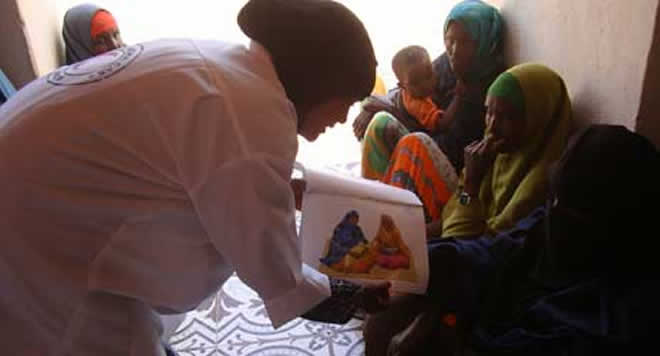
Health staff provide lactating mothers with infant feeding education at the Kalabeyr clinic.

By Aradhna Duggal, IFRC Health Communication
Tuesday, May 19, 2015
"About two months ago a teenage girl committed suicide. She was pregnant. Pregnancy before marriage is not acceptable in this society. Even if the girl was to go to a clinic, she would have been turned away. She simply would not have been able to access the required care. Talking about sexual and reproductive health is still regarded as a taboo in my society, young people need increased access to education in reproductive health", says Mahmuud Suleiman Mohamed, a volunteer with the Somali Red Crescent Society.
"Not letting adolescent girls have access to reproductive health is a human rights violation. This must end", he adds.
The maternal and child mortality rates for Somalia are amongst the highest in the world. In terms of under-five mortality, Somalia ranks four (UNICEF). “Some of the major challenges Somali mothers face are linked to lack of access to emergency obstetric care for timely treatment of childbirth-related complications such as haemorrhage, obstructed labour and infection”, says Ahmed Mohammed Ahmed, Deputy National Health Officer with the Somali Red Crescent Society in Mogadishu.
Since 1991, the Somali Red Crescent Society has been delivering integrated healthcare programmes to the communities initially with a network of static maternal and child health outpatient clinics and later, mobile health units across the three zones, i.e. Somaliland, Puntland and central and south Somalia.
Safe motherhood is one of the essential health services provided by health workers. The Somali Red Crescent Society has a history of working with and supporting traditional birth attendants (now re-trained and re-designated health promoters) who provide a link between the community and the health facilities and support clinical attendance. The clinic staff work with traditional birth attendants (health promoters) who provide information on antenatal care, vaccination (tetanus toxoid vaccine) and births and bring or refer women in labour to the clinic for facility-based deliveries, postnatal care and infant and young child feeding.
The Somali Red Crescent Society clinics routinely provide nutrition services to all under-five children irrespective of their nutrition status. Severely malnourished children without complications are admitted to the outpatient therapeutic feeding programme for treatment. Moderately and severely malnourished children with complications are referred to facilities managed by other partners that run supplementary feeding programmes.
Feeding practices relating to breastfeeding – including breastfeeding within the first hour of an infant’s life, exclusive breastfeeding for the first six months and continued breastfeeding for up to two years – are extremely poor at 23 per cent, 5.3 per cent and 26.8 per cent respectively (UNICEF).
“Convincing mothers to move away from traditional practices such as giving a concoction of water and sugar as first food to newborn babies is a challenge but one that we have been able to slowly overcome by raising awareness and increasing knowledge around the importance of exclusive breastfeeding for the first six months. We can see behaviour change in areas where clinics are operating”, says Ahmed Mohammed.
There are also socio-economic factors, such as food insecurity, which result in poor diets for all members of a household. This particularly affects lactating mothers and young children. “To address this issue, we launched an infant and young child feeding programme. Health promoters have been trained and are visiting households to raise further awareness,” he adds.
In central and south Somalia, midwives and head nurses have been trained on clinical management of rape. “Midwives work with women who have faced sexual and gender-based violence [SGBV], maintaining discretion and confidentiality. If the rape case is known to the midwives within the first 120 hours, they provide the necessary care and support, else they refer the case to a NGO that has the expertise in dealing with SGBV issues”, shares Ahmed Mohammed.
The cooperation between the Somali Red Crescent Society and the local health authorities has enabled hard-to-reach communities to access healthcare, bridging the gap between the formal and community health systems. By the end of 2014, the National Society was operating 68 static and 29 mobile clinics across all the 19 regions of the country, enabling communities to access healthcare services. Overall, 154,546 pregnant women sought antenatal care. A total of 10,715 babies were delivered in clinics with 70,181 women accessing postnatal care services during the same period.
Volunteers and traditional birth attendants as health promoters in the community has been vital in promoting health seeking behaviour and practices at the community level. It is estimated that unskilled health workers perform 90 per cent of the deliveries at home. However, the trend is changing within the target communities. This change can be attributed to the partnership with the World Food Programme (WFP) as well as the improved quality of services with the addition of maternity wings with delivery facilities at the maternal and child health and outpatient clinics.